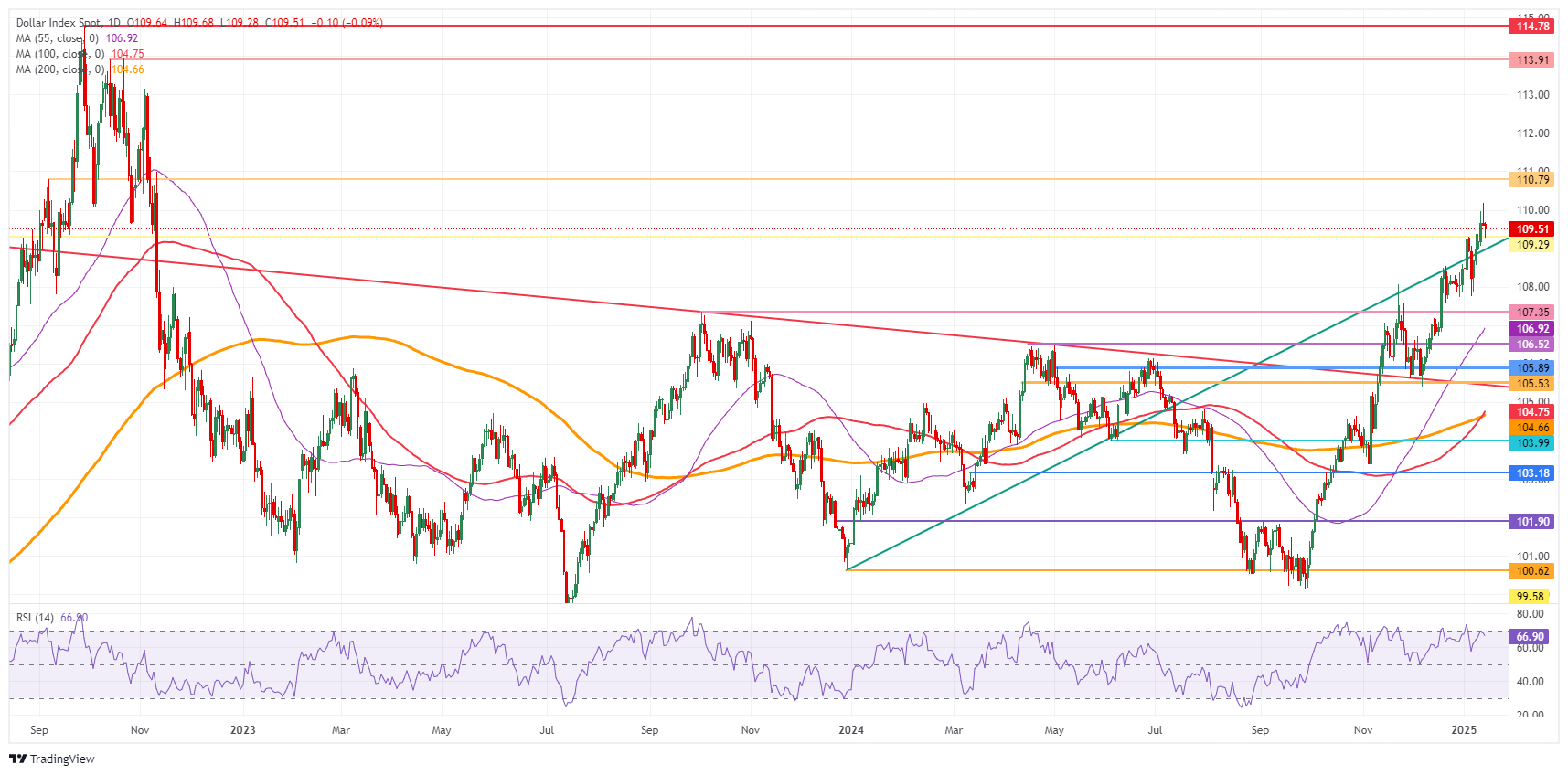
- The US Dollar turns softer again after the December Producer Price Index got released.
- Traders are on edge over possible comments from President-elect Donald Trump on the above headline.
- The US Dollar Index (DXY) dips below 110.00 and looks for support to bounce back.
The US Dollar Index (DXY), which tracks the Greenback’s value against six major currencies, is trading softer after the December Producer Price Index report came in softer than expected. The main driver this Tuesday remains comments from team memberes from the upcoming President-elect Donald Trump administration, who disclosed that they are considering a very slow month-to-month implementation of tariffs to avoid an inflationary shock, Bloomberg reported. Meanwhile markets are on edge over any comments from President-elect Donald Trump himself on the matter.
The US economic calendar picks up in importance on Tuesday, with the Producer Price Index (PPI) release as an appetizer for the more important Consumer Price Index (CPI) on Wednesday. Every number in the report, both Headline and Core gauge for the monthly and yearly time frame came in substantially softer than expected. This should ease expectations a touch for the upcoming CPI release on Wednesday.
Daily digest market movers: Not that hot
- The Producer Price Index (PPI) for December came in softer than expected:
- The monthly core PPI gauge increased by 0.0%, below the 0.3% expected and compared to 0.2% in November.
- The monthly headline PPI went to 0.2%, softer than the 0.3% survey and lower than the 0.4% in the previous month.
- The yearly headline PPI increased by 3.3%, below the expected 3.4%, and up from 3.0% in November, while the annual core PPI jumped to 3.5%, below the 3.8% survey expectation and up from 3.4% in the previous month.
- At 15:00 GMT, Federal Reserve Bank of Kansas City President Jeff Schmid delivers a speech about the US economic and monetary policy outlook at an event organized by The Central Exchange.
- At 20:05 GMT, Federal Reserve Bank of New York President John Williams delivers open remarks at the “An Economy That Works for All: Housing Affordability” event organized by the New York Fed in New York.
- European equities and US futures are welcoming the softer than expected PPI reading, with all major indices in the green on the day.
- The CME FedWatch Tool projects a 97.3% chance that interest rates will be kept unchanged at current levels in the January meeting. Expectations are for the Federal Reserve (Fed) to remain data-dependent with uncertainties that could influence the inflation path once President-elect Donald Trump takes office on January 20.
- US yields are softening substantially. The 10-year benchmark trades around 4.781% at the time of writing on Tuesday, fading from its fresh 14-month high of 4.802% seen on Monday.
US Dollar Index Technical Analysis: Watch out for comments
The US Dollar Index (DXY) is set to see volatility pick up. The constant deliverance of statements from President-elect Donald Trump, followed by comments from sources inside his team, will deliver several knee-jerk moments and reactions. This means that sense of direction could get distorted and misty from now on.
On the upside, the 110.00 psychological level remains the key resistance to beat. Further up, the next big upside level to hit before advancing any further remains at 110.79. Once beyond there, it is quite a stretch to 113.91, the double top from October 2022.
Looking down, the DXY will look for a bounce off the green ascending trend line from December 2023, which currently comes in around 109.00 as nearby support. In case of more downside, the next support is 107.35. The next level that might halt any selling pressure is 106.52, with the 55-day Simple Moving Average (SMA) at 106.92 reinforcing ahead of this region of support.
US Dollar Index: Daily Chart
Fed FAQs
Monetary policy in the US is shaped by the Federal Reserve (Fed). The Fed has two mandates: to achieve price stability and foster full employment. Its primary tool to achieve these goals is by adjusting interest rates. When prices are rising too quickly and inflation is above the Fed’s 2% target, it raises interest rates, increasing borrowing costs throughout the economy. This results in a stronger US Dollar (USD) as it makes the US a more attractive place for international investors to park their money. When inflation falls below 2% or the Unemployment Rate is too high, the Fed may lower interest rates to encourage borrowing, which weighs on the Greenback.
The Federal Reserve (Fed) holds eight policy meetings a year, where the Federal Open Market Committee (FOMC) assesses economic conditions and makes monetary policy decisions. The FOMC is attended by twelve Fed officials – the seven members of the Board of Governors, the president of the Federal Reserve Bank of New York, and four of the remaining eleven regional Reserve Bank presidents, who serve one-year terms on a rotating basis.
In extreme situations, the Federal Reserve may resort to a policy named Quantitative Easing (QE). QE is the process by which the Fed substantially increases the flow of credit in a stuck financial system. It is a non-standard policy measure used during crises or when inflation is extremely low. It was the Fed’s weapon of choice during the Great Financial Crisis in 2008. It involves the Fed printing more Dollars and using them to buy high grade bonds from financial institutions. QE usually weakens the US Dollar.
Quantitative tightening (QT) is the reverse process of QE, whereby the Federal Reserve stops buying bonds from financial institutions and does not reinvest the principal from the bonds it holds maturing, to purchase new bonds. It is usually positive for the value of the US Dollar.


